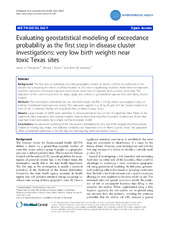| dc.creator | Thompson, James A | |
| dc.creator | Bissett, Wesley T | |
| dc.creator | Sweeney, Anne M | |
| dc.date.accessioned | 2014-11-18T22:17:53Z | |
| dc.date.available | 2014-11-18T22:17:53Z | |
| dc.date.issued | 2014-06-07 | |
| dc.identifier.citation | Thompson, J. A., Bissett, W. T., & Sweeney, A. M. (2014). Evaluating geostatistical modeling of exceedance probability as the first step in disease cluster investigations: very low birth weights near toxic Texas sites. Environmental Health, 13, 47. doi:10.1186/1476-069X-13-47 | en |
| dc.identifier.uri | http://dx.doi.org/10.1186/1476-069X-13-47 | |
| dc.identifier.uri | https://hdl.handle.net/1969.1/152276 | |
| dc.description.abstract | Background
The first step in evaluating potential geographic clusters of disease calls for an evaluation of the disease risk comparing the risk in a defined location to the risk in neighboring locations. Environmental exposures, however, represent continuous exposure levels across space not an exposure with a distinct boundary. The objectives of the current study were to adapt, apply and evaluate a geostatistical approach for identifying disease clusters.
Methods
The exceedance probability for very low birth weight (VLBW; < 1.5 kg) infants was mapped using an Intrinsic Conditional Autoregressive model. The data were applied to a 20 by 20 grid of 1 km2 pixels centered on each of the 13 National Priority List Superfund Sites in Harris County, Texas.
Results
Large clusters of VLBW were identified in close proximity to four of the 13 Superfund Sites. Three of the Superfund Sites, associated with disease clusters, were located close together in central Houston and these sites may have been surrounded by a single, confluent disease cluster.
Conclusions
Geostatistical modeling of the exceedance probability for very low birth weights identified disease clusters of varying size, shape and statistical certainty near Superfund Sites in Harris County, Texas. The approach offers considerable potential as the first step for investigating potential disease clusters. | en |
| dc.description.sponsorship | The open access fee for this work was funded through the Texas A&M University Open Access to Knowledge (OAK) Fund. | en |
| dc.language.iso | en_US | |
| dc.publisher | BioMed Central | |
| dc.rights | Attribution 3.0 United States | en |
| dc.rights.uri | http://creativecommons.org/licenses/by/3.0/us/ | |
| dc.title | Evaluating geostatistical modeling of exceedance probability as the first step in disease cluster investigations: very low birth weights near toxic Texas sites | en |
| dc.type | Article | en |
| local.department | Large Animal Clinical Sciences | en |
| local.department | Other | en |
| dc.rights.requestable | false | en |



